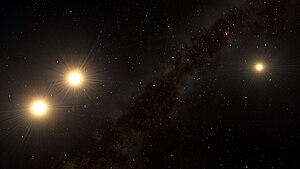| Observation data Epoch J2000 Equinox J2000 | |
|---|---|
| Constellation | Aquarius |
| Right ascension | 22h 38m 33.73s[1] |
| Declination | −15° 17′ 57.3″[1] |
| Apparent magnitude (V) | 12.38[2] (13.03/13.27/15.07)[3] |
| Characteristics | |
| Spectral type | M5 V[3] |
| B−V color index | +1.96[4] |
| Variable type | Flare star + BY Dra[5] |
| Astrometry | |
| Radial velocity (Rv) | −59.9[6] km/s |
| Proper motion (μ) | RA: +2314[7] mas/yr Dec.: +2295[7] mas/yr |
| Parallax (π) | 293.6 ± 0.9 mas[8] |
| Distance | 11.11 ± 0.03 ly (3.41 ± 0.01 pc) |
| Absolute magnitude (MV) | 14.75[9] (15.33/15.58/17.37)[3] |
| Orbit[10] | |
| Primary | EZ Aquarii AC |
| Companion | EZ Aquarii B |
| Period (P) | 2.2506±0.0033 yr |
| Semi-major axis (a) | 0.346±0.004″ |
| Eccentricity (e) | 0.437±0.007 |
| Inclination (i) | 112.4±0.5° |
| Longitude of the node (Ω) | 162.1±0.4° |
| Periastron epoch (T) | 1987.236 ± 0.014 |
| Argument of periastron (ω) (secondary) | −17.7±1.1° |
| Details | |
| EZ Aquarii A | |
| Mass | 0.1187±0.0011[8] M☉ |
| Radius | 0.175[11] R☉ |
| Luminosity | 0.00078[8] L☉ |
| EZ Aquarii C | |
| Mass | 0.0930±0.0008[8] M☉ |
| Luminosity | 0.00012[8] L☉ |
| EZ Aquarii B | |
| Mass | 0.1145±0.0012[8] M☉ |
| Radius | 0.21±0.04[8] R☉ |
| Temperature | 2650±200[8] K |
| Other designations | |
| Database references | |
| SIMBAD | data |
Location of EZ Aquarii in the constellation Aquarius | |
EZ Aquarii is a triple star system 11.1 light-years (3.4 parsecs) from the Sun in the constellation Aquarius within the Milky Way. It is also known as Luyten 789-6, Gliese 866 and LHS 68. It is a variable star showing flares as well as smaller brightness changes due to rotation. The aggregate mass of the system is 0.3262±0.0018 solar masses.[8] All three seem to have masses close to the hydrogen burning mass limit.[10]
William E. Kunkel announced that Luyten 789-6 was a flare star in 1972, after having observed seven flares.[14] It was given its variable star designation, EZ Aquarii, in 1978.[15]
The configuration of the inner binary pair may permit a circumbinary planet to orbit near their habitable zone, however no exoplanets have yet been observed.[16] EZ Aquarii is approaching the Solar System and, in about 32,300 years, will be at its minimal distance of about 8.2 ly (2.5 pc) from the Sun.[17] The ChView simulation shows that currently its nearest neighbouring star is Lacaille 9352 at about 4.1 ly (1.3 pc) from EZ Aquarii.
- ^ a b Cite error: The named reference
2MASSwas invoked but never defined (see the help page). - ^ Cite error: The named reference
ucac4was invoked but never defined (see the help page). - ^ a b c Cite error: The named reference
RECONSwas invoked but never defined (see the help page). - ^ Cite error: The named reference
apj142_925was invoked but never defined (see the help page). - ^ Cite error: The named reference
gcvswas invoked but never defined (see the help page). - ^ Cite error: The named reference
gcsrvwas invoked but never defined (see the help page). - ^ a b Cite error: The named reference
apj582_2_1011was invoked but never defined (see the help page). - ^ a b c d e f g h i Cite error: The named reference
Torres2009was invoked but never defined (see the help page). - ^ Cite error: The named reference
houdebine2003was invoked but never defined (see the help page). - ^ a b Cite error: The named reference
aaa353_253was invoked but never defined (see the help page). - ^ Routley, Nick (June 26, 2020). "The 44 Closest Stars and How They Compare to our Sun". Visual Capitalist. Retrieved January 5, 2023.
- ^ Cite error: The named reference
Gliese1991was invoked but never defined (see the help page). - ^ Cite error: The named reference
SIMBADwas invoked but never defined (see the help page). - ^ Cite error: The named reference
Kunkelwas invoked but never defined (see the help page). - ^ Cite error: The named reference
Kholopovwas invoked but never defined (see the help page). - ^ Cite error: The named reference
Popova2016was invoked but never defined (see the help page). - ^ Cite error: The named reference
al36_11_816was invoked but never defined (see the help page).

